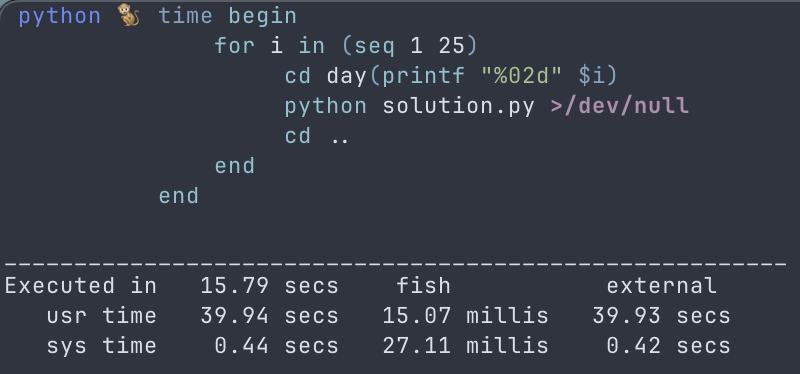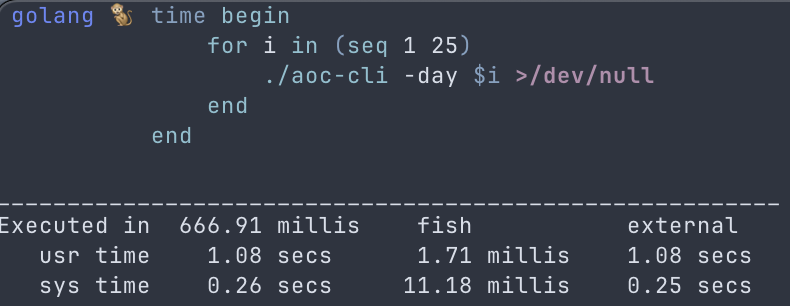
Advent of Code 2024 - Golang Time
- 4 minsOnce Christmas arrived, I had all my 50 stars for Advent of Code 2024! I had a lot of fun solving the puzzles and I learned a lot of new things. After Christmas, people started posting their overall execution times for all the puzzles in different languages. Someone posted their times for all the puzzles in Golang and I was surprised to see that they got all running in less than 1 second! When I saw that, I timed my python solutions, and in general my solutions altogether were at about 16 seconds.

I recently read Go Programming in Easy Steps, and learnt the basic syntax and most if not all of the features that Go has built in. I thought it would be a good idea to port my solutions to Go and get some practice with the language. Along the way, I learned a lot of the Go idiosyncrasies and how to use the standard library to solve problems. A lot of the content I’ve read online about Go talks about how there are very simple constructs in Go that have no higher level abstractions, and that allowed efficient code to be written. I found that to be true in my experience as well.
Main takeaways from porting Python to Go
- Go doesn’t have list comprehensions or any other comprehensions for that matter. This wasn’t a big deal, but it did make the code a bit more verbose. Also forced me to think about sizes of slices and maps when creating them.
- Go doesn’t have a built-in
setdata structure. I had to use a map withstruct{}as the value to simulate a set. Again, not an issue, just more LOC. - Goroutines are really easy to use. Most of my code was fast enough without needing to use goroutines, but I did use them in a few places where I didn’t need context from the previous iteration.
- Related to the above, channels are also really easy to use. I used them in conjunction with goroutines, letting me not worry about mutexes and locks.
- Go’s tooling is really good. Testing can be done without any complex setup, and the
go testcommand is really easy to use. Profiling is also built in, and I used it to determine where I should focus my optimization efforts. - Handling errors in Go forces you to think about what to do with them. They are more of a first-class citizen in Go, and you get to explicitly know where errors can occur.
- Go doesn’t really do sum types. I had to use empty interfaces to simulate them, which was a bit of a pain. I’m sure there are better ways to do this, but I didn’t find them in my limited time with Go.
Results
After porting and optimizing my solutions, I was able to get all the puzzles to run in under a second too!

I only used two external libraries: one for generating combinations and one for finding maximal cliques in a graph. I used networkx in Python for the latter anyway, so I didn’t feel bad about using a library for that. Combinations were built in with itertools in Python, so I used a library for that in Go too. Here are the libraries I used:
I also missed functools.cache from Python. I implemented a simple cache with a global map in Go, but the cache decorator in Python is much more elegant.
A lot of my code follows the same logic as the Python code, just with more lines due to the lack of comprehensions. I’m sure there are more optimizations that can be done, but I’m happy with the results I got.
I’ve uploaded all my solutions to my Advent of Code repo. Now I’m looking forward to Advent of Code 2025, and maybe I’ll try to solve previous years’ puzzles in Go too!
If anyone wants to try out my solutions, feel free to do so. The input files need to be downloaded from the Advent of Code website and placed in the inputs directory. I have a shell script can download the inputs on the repo as well, you need to get your session cookie from the website and put it in the same directory as the script.
